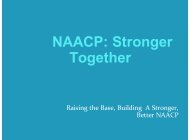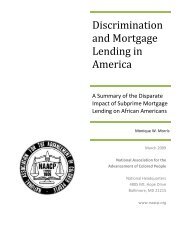TOOLKIT
TOOLKIT
TOOLKIT
Create successful ePaper yourself
Turn your PDF publications into a flip-book with our unique Google optimized e-Paper software.
their homes from a toxic assault -- drew national media attention and fired the imagination of<br />
people across the country that had lived through similar injustice. The street protests and legal<br />
challenges mounted by the people of Warren County to fight the landfill are considered by many<br />
to be the first major milestone in the national movement for environmental justice.<br />
Other communities of color had organized to oppose environmental threats before Warren<br />
County. In the early 1960s, Latino farm workers organized by Cesar Chavez fought for<br />
workplace rights, including protection from harmful pesticides in the farm fields of California's<br />
San Joaquin valley. In 1967, African-American students took to the streets of Houston to<br />
oppose a city garbage dump in their community that had claimed the lives of two children. In<br />
1968, residents of West Harlem, in New York City, fought unsuccessfully against the citing of a<br />
sewage treatment plant in their community. But the Warren County protests marked the first<br />
instance of an environmental protest by people of color that garnered widespread national<br />
attention.<br />
The Movement Takes Hold<br />
The first national study on environmental racism was published by the United Church of Christ’s<br />
Commission for Racial Justice in 1987 titled: “Toxic Wastes and Race in the United States.”<br />
The study provided data that matched waste facility sites to demographics demonstrating a<br />
strong pattern of environmental racism. Environmental racism “refers to any policy, practice, or<br />
directive that differentially affects or disadvantages (whether intended or unintended)<br />
individuals, groups, or communities because of their race or color.” 4 While traditional<br />
environmental education programs give people a deeper understanding of the environment,<br />
inspiring them to take personal responsibility for its preservation and restoration, 5 environmental<br />
justice education fosters a critical understanding of the environment within the context of<br />
human, political, and social actions.<br />
For some time the focus in the field centered on the impact of environmental injustice on health<br />
in the United States. However, with the strong presence of community-based grassroots<br />
change, environmental justice has broadened to include “benefits and amenities. For example,<br />
the themes of open space and waterfront access, environmental benefits that historically have<br />
been withheld from communities of color.” 6<br />
The First National People of Color Environmental Leadership Summit was held in October of<br />
1991. The assembled group established The Seventeen Principles of Environmental Justice<br />
and introduced an important aspect of social justice to an international audience. These<br />
principles call people to “begin to build a national and international movement of all peoples of<br />
color to fight the destruction and taking of our lands and communities, [and to] re-establish our<br />
spiritual interdependence to the sacredness of our Mother Earth” 7<br />
The Second National People of Color Environmental Leadership Summit was held in October of<br />
2002 and focused on solidifying the points of 1991 as well as building structured connections<br />
between local, grassroots environmental justice community groups and larger mainstream<br />
organizations. This summit highlighted the fact that the environmental justice movement has<br />
grown through local community determination.<br />
8 | P a g e








